Japanese bedroom design ideas have captivated the minds and hearts of many homeowners around the globe. It’s no wonder, considering the strong desire people everywhere have for tranquil, harmonious, and beautiful sleeping spaces. If you’re dreaming of a bedroom that melts away stress and feels like your private escape, you’ll find plenty of inspiration right here. We’ll guide you through 25 stunning interpretations—ranging from traditional tatami settings to modern Japandi bedroom blends—that invite peace and mindfulness into your everyday life.
In this comprehensive guide, you’ll discover everything from Zen minimalism to artful accessories and innovative layouts for small spaces. Whether your space is sprawling or compact, you’re sure to find Japanese bedroom design ideas that will fit your lifestyle and satisfy your desire for serenity. The following sections offer bold yet straightforward tips, sprinkled with interactive advice and visual suggestions to help you create your very own calming retreat. Let’s unleash the artistry and balance of Japanese home design in your bedroom!
Minimalist Zen Spaces
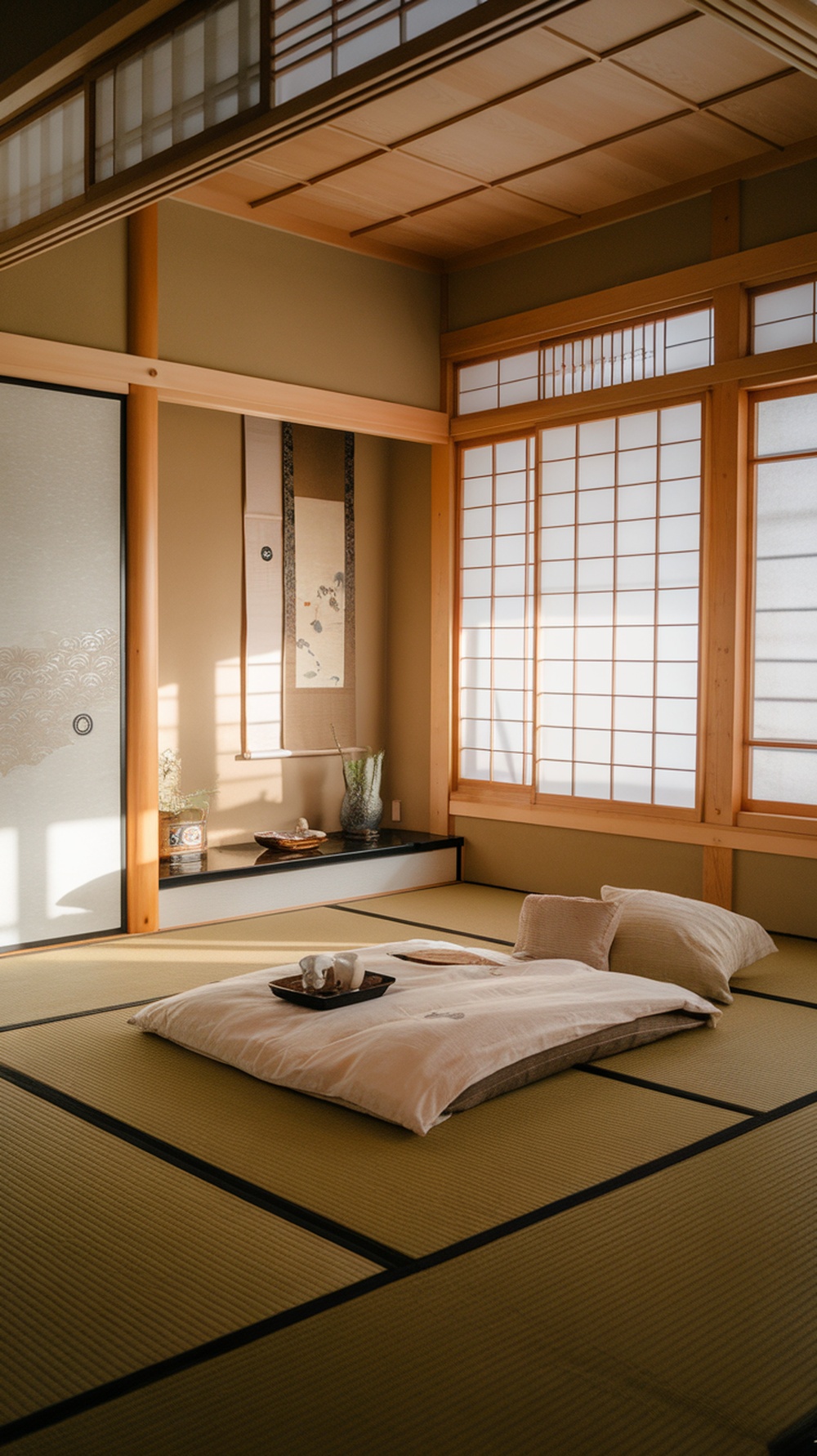
When it comes to Japanese bedroom design ideas, minimalism isn’t just a trend—it’s a philosophy. Every item has a purpose, and there’s a general sense that less truly is more. Creating a minimalist Zen space starts with decluttering. Remove anything that doesn’t serve a meaningful purpose, from unused gadgets to excessive décor. Think open spaces, unadorned floors, and furniture with clean lines. Minimalism isn’t about emptiness, but about letting each element breathe and contribute to a calming environment. You can begin this transformation by selecting a low-modern bed frame, paired with discreet, hidden storage.
The result is a bedroom that feels tranquil and mentally liberating. Japanese bedrooms are renowned for their soothing visual balance, making every night’s sleep restorative. With fewer distractions, your mind finds it easier to switch off and embrace relaxation. Wondering how to style your Japandi bedroom for optimal calm? Keep colors neutral, incorporate simple artwork, and focus on essential comforts rather than ornamental clutter. It’s this dedication to purposeful design that makes minimalist Zen spaces so timelessly compelling.
Indoor Plants and Tranquility
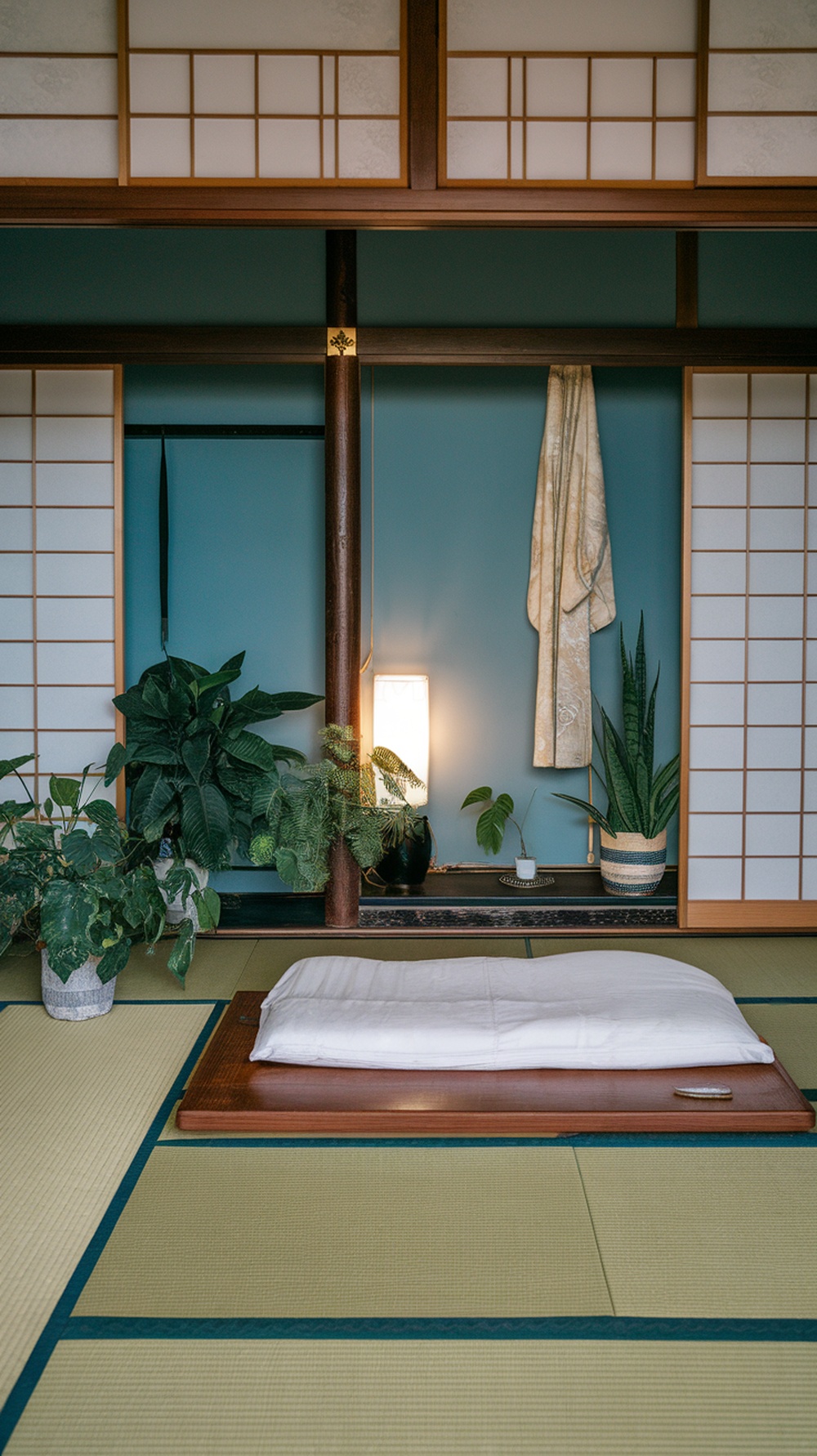
A journey through Japanese bedroom design ideas wouldn’t be complete without mentioning the indoor-outdoor connection. Japanese culture reveres nature, and bringing greenery into the bedroom underscores that deep respect. Choose plants known for their calming qualities—think ferns, bonsai, peace lilies, or lucky bamboo. Arrange a few potted plants where sunlight can reach them, or place a small garden in a corner to act as a living sculpture. Not only do plants boost oxygen levels, but their presence also cools the energy of the room, making it feel truly serene.
A key aspect of the Japanese bedroom aesthetic is the subtle interplay between nature and living spaces. Consider trailing vines up a window or a single statement plant next to your futon. This living element will anchor your attention, reduce stress, and create a sense of retreat. For those worried about upkeep, opt for resilient choices like snake plants or ZZ plants that require minimal care. Remember, even a few green accents can dramatically shift the atmosphere, intensifying the oasis-like quality that defines the Japanese-inspired bedroom.
Tatami Mat Floors
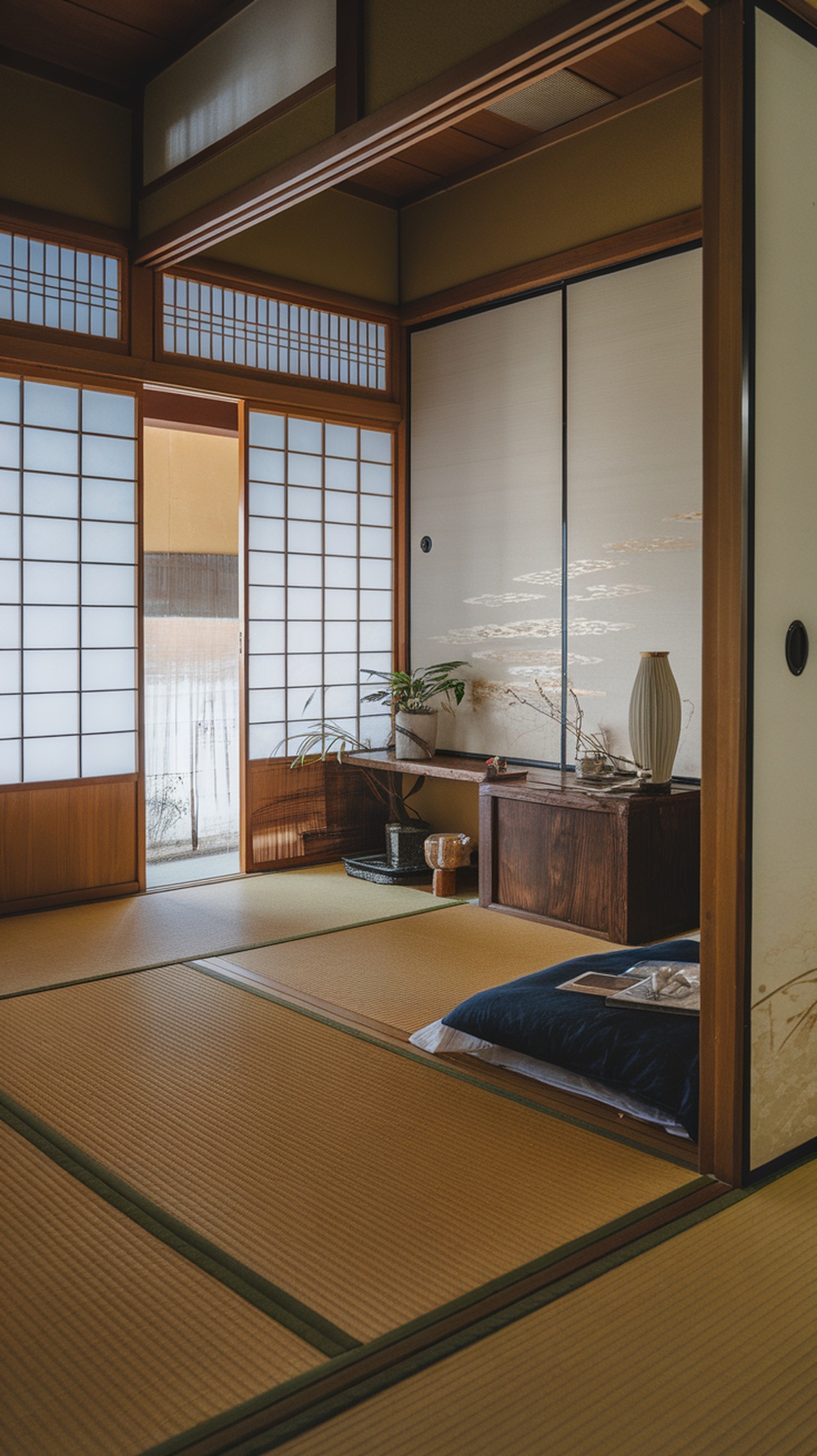
Tatami mats are the heartbeat of a traditional Japanese bedroom. These woven straw mats are more than a surface—they’re a sensory experience. Step onto a tatami floor, and you’ll immediately feel grounded, connected to the earth beneath you. Incorporating tatami into your Japanese bedroom design ideas not only establishes an authentic look but also brings in an element of softness, warmth, and organic simplicity. Mats can be arranged wall-to-wall, or you might use a couple to define a bedding or reading space.
The natural scent of the mats offers a subtle, grassy aroma that instantly relaxes. If you’re aiming for a Japanese style bedroom modern vibe, pair tatami with minimalist wooden furnishings and soft textural throws for the ideal blend. These mats are also known for their thermal properties—they feel cool during summer and cozy during chilly evenings. Their texture absorbs sound, enhancing the quietude that’s so essential to a tranquil sleep zone. Whether you’re going for a full room or a smaller tatami corner, it’s a Japanese bedroom design idea that can transform your space inside and out.
Natural Wood Elements
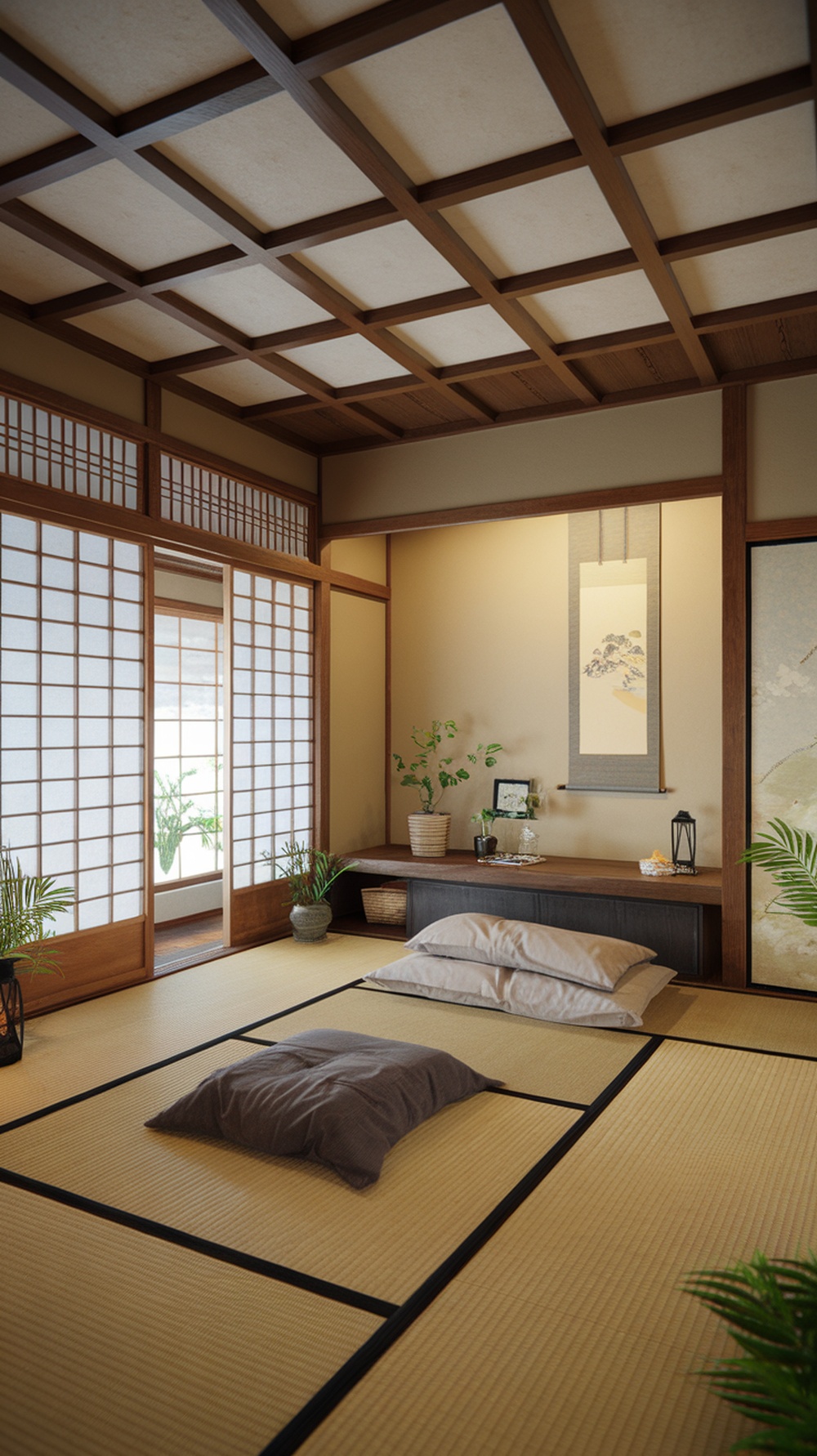
Japanese bedroom design ideas are incomplete without natural wood accents. Wood in Japanese interiors is never just decoration—it’s about celebrating organic textures and craftsmanship. Use light-toned hardwood such as ash, cypress, or bamboo for bed frames, side tables, or shelves. Their smooth, unvarnished finish allows the wood’s natural grain to shine, imbuing your space with earthy warmth. These wood elements pair perfectly with both Japandi bedroom ideas and more traditional themes.
Layering wooden surfaces—like exposed ceiling beams, wall cladding, or a simple wooden bench—creates an understated sophistication. Even small details, like wooden lamp stands or trays, contribute to a welcoming vibe. The consistency of wood textures instantly balances out synthetic materials or chilly color schemes, warming up your entire bedroom. This approach makes your Japanese-inspired bedroom feel timeless, inviting, and grounded—a true celebration of Japanese craftsmanship and design philosophy.
Harmonious Color Palettes
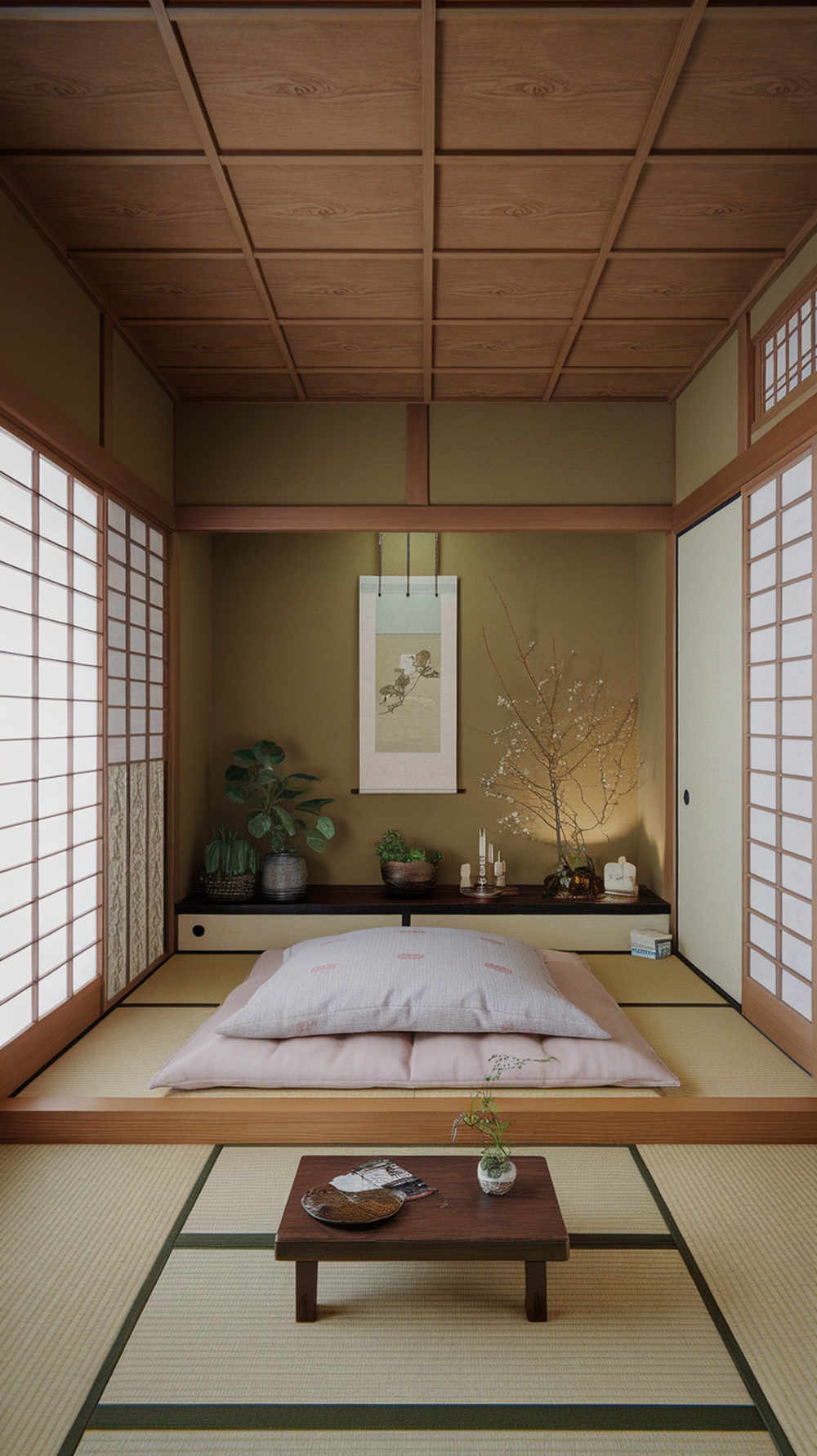
One of the most enduring Japanese bedroom design ideas involves crafting a harmonious color palette. Japanese interiors favor muted, calm colors that echo nature. Think soft creams, pale greens, stone grays, sandy taupes, and warm browns. These hues set the mood for rest and meditation, helping you to relax after a long day. Avoid jarring, overly bright colors—these can disturb the tranquil atmosphere you’re aiming for.
If you’d like to introduce a pop of color, select just one accent—such as a dusty blue throw or mossy green cushion—tied to the natural elements in your room. The overarching goal is unity, rather than contrast. You’ll notice that these harmonious palettes not only please the eye but also settle the mind. It’s a foundation that beautifully supports the entire Japanese bedroom aesthetic, allowing you to layer on accessories, lighting, or artwork without visual noise.
Sliding Shoji Screens
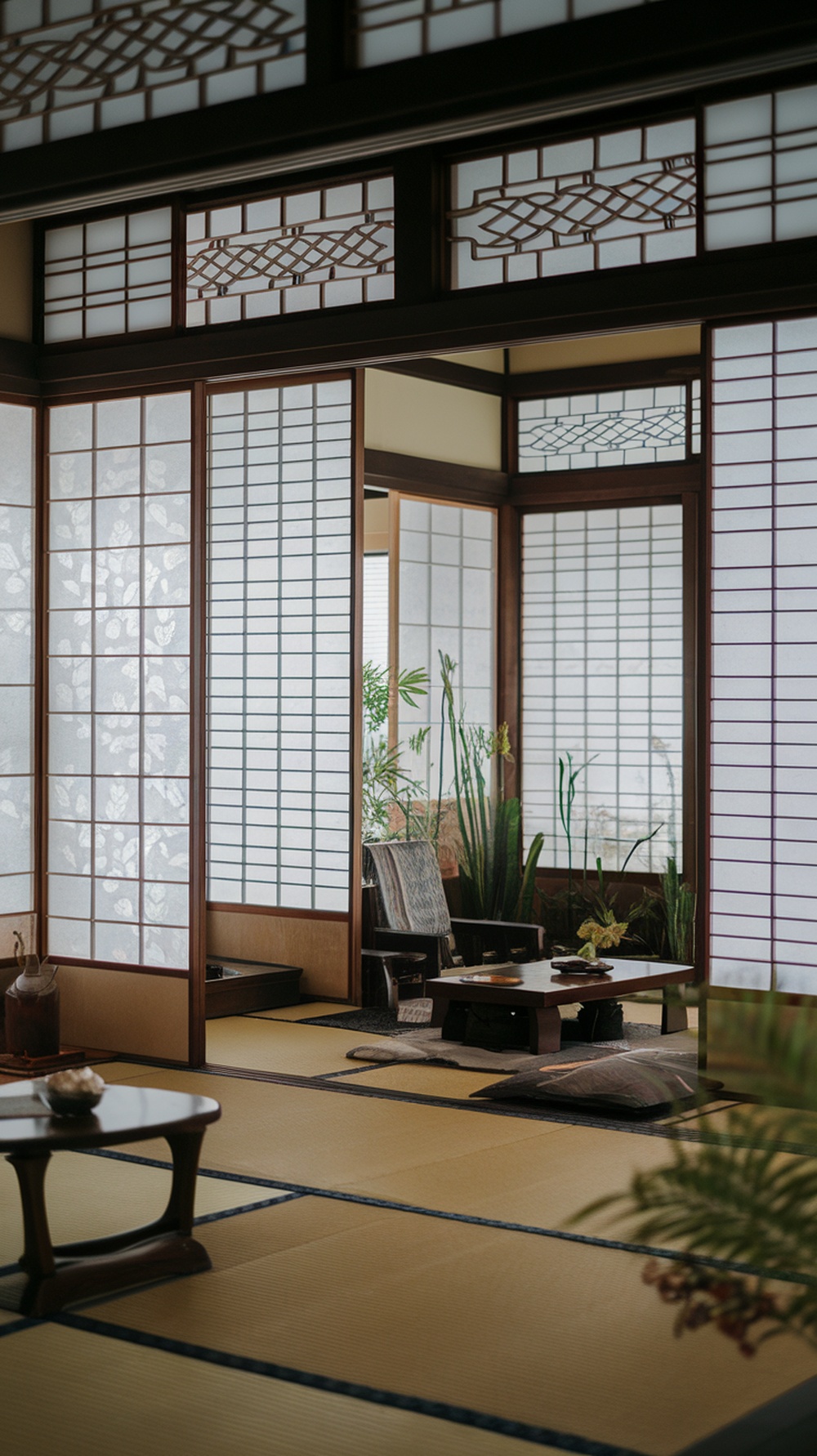
Sliding shoji screens are iconic in Japanese bedroom design ideas. Crafted from translucent paper and a delicately latticed wood frame, shoji screens serve both functional and decorative roles. They divide spaces without making them feel closed-off, diffusing natural light with a soft, magical glow. If your bedroom doubles as a lounge or workspace, sliding shoji screens provide flexible boundaries while keeping the space visually open.
You can use shoji screens as closet doors, window coverings, or even headboard replacements. Their minimal form complements both modern and traditional Japanese bedrooms. Shoji screens make any room feel instantly more elegant, reinforcing the subtlety and calm that underpin Japanese home design. Plus, their lightweight construction means they can be moved or swapped as your needs change, giving you both versatility and enduring style.
Low-Profile Furniture
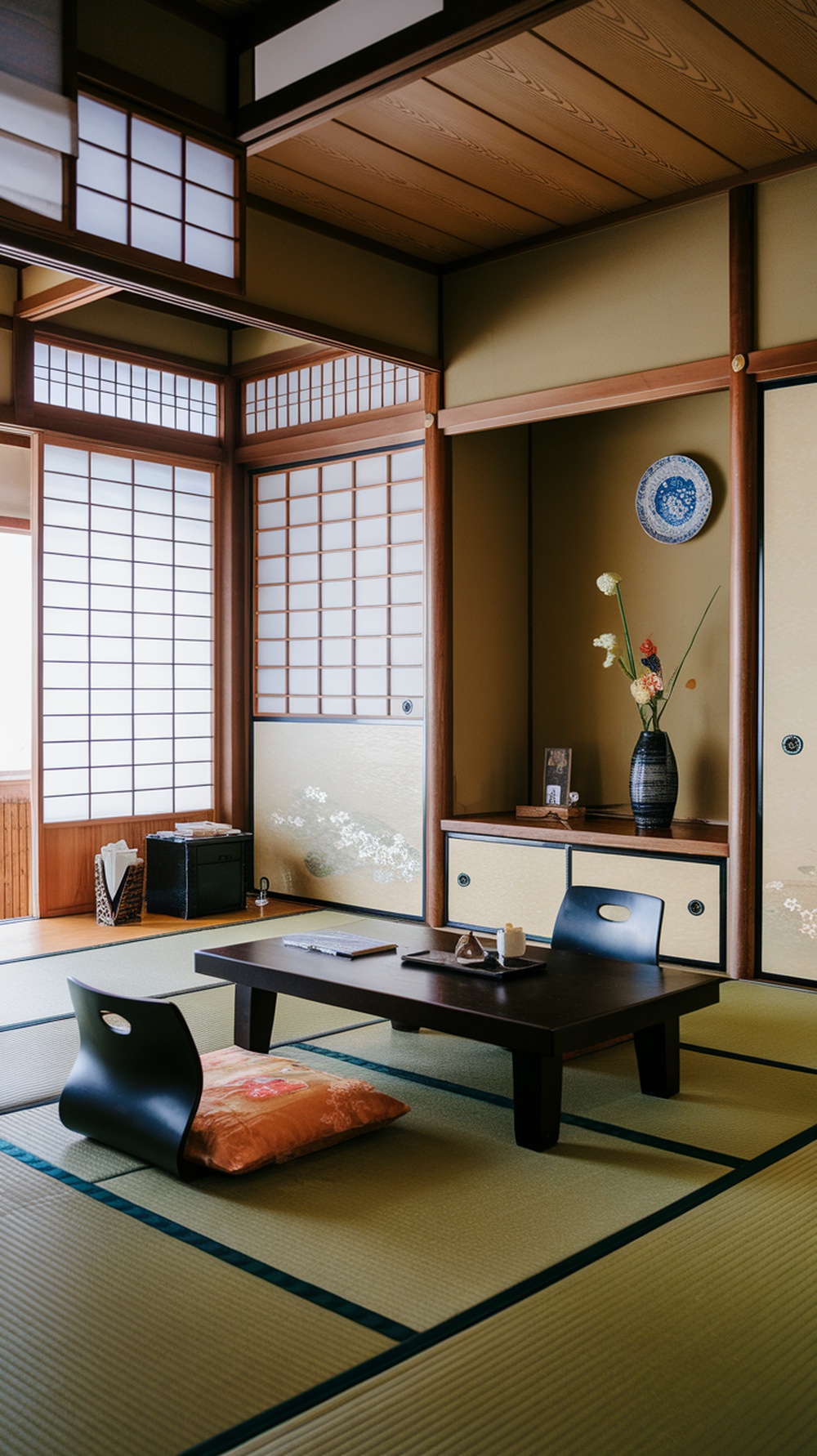
Low-profile furniture is central to Japanese bedroom design ideas. Beds, desks, and tables are often set close to the ground, fostering a physical connection to your environment. This creates a unique flow, making ceilings seem higher and rooms feel larger, even in smaller spaces. A simple, low bed frame with slim legs and a platform base perfectly embodies the Japanese style bedroom concept—practical, stylish, and unobtrusive.
Pair your bed with equally understated nightstands and a floor-level reading nook. The sense of openness is enhanced, giving your bedroom an uncluttered, breezy feel. This furniture arrangement encourages sitting on the floor—a deeply rooted habit in Japanese culture—creating opportunities for floor-based relaxation, meditation, and daily rituals. The result is an intimate yet expansive space that’s perfect for unwinding.
Futon Bedding and Floor Layout
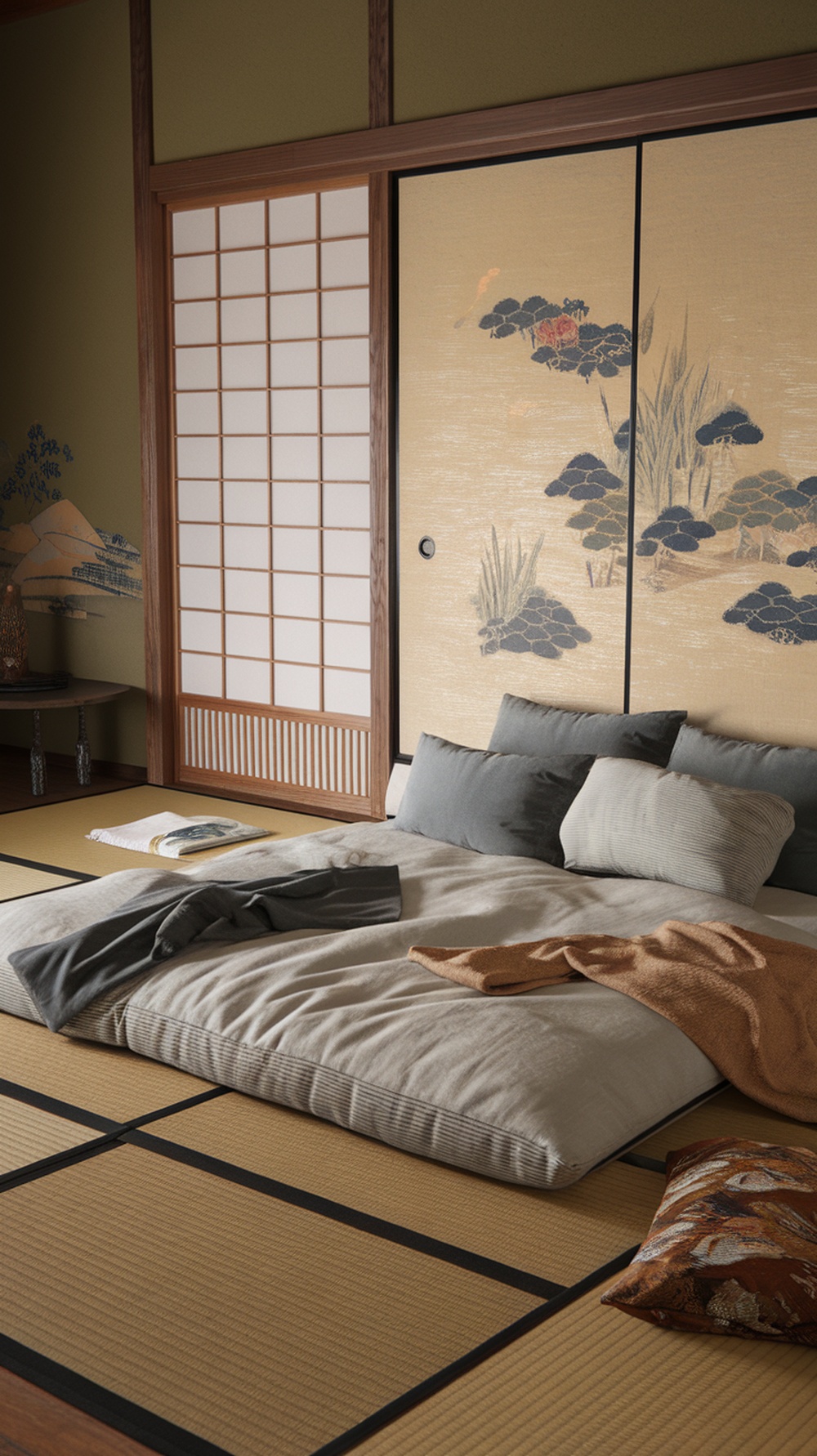
One of the most practical Japanese bedroom design ideas is traditional futon bedding. Unlike Western beds, futons are thin, foldable mattresses that rest directly on the floor, easily stowed away during daylight hours to maximize usable space. Adopting this layout gives your room a neat, adaptable feel, perfect for multi-use bedrooms or studio apartments.
Modern takes on this system use soft, high-quality futons topped with plush duvets and pillows, creating layers of comfort without sacrificing simplicity. The main benefit? You instantly gain flexibility. Layer mats for extra cushioning or keep things streamlined for a firmer sleep. This ancient tradition doesn’t just save space—it encourages a minimalist lifestyle and lets your bedroom breathe. If you’re after a Modern Japanese Bedroom or Japandi bedroom office concept, incorporating a futon system is both stylish and efficient.
Natural Light and Open Spaces
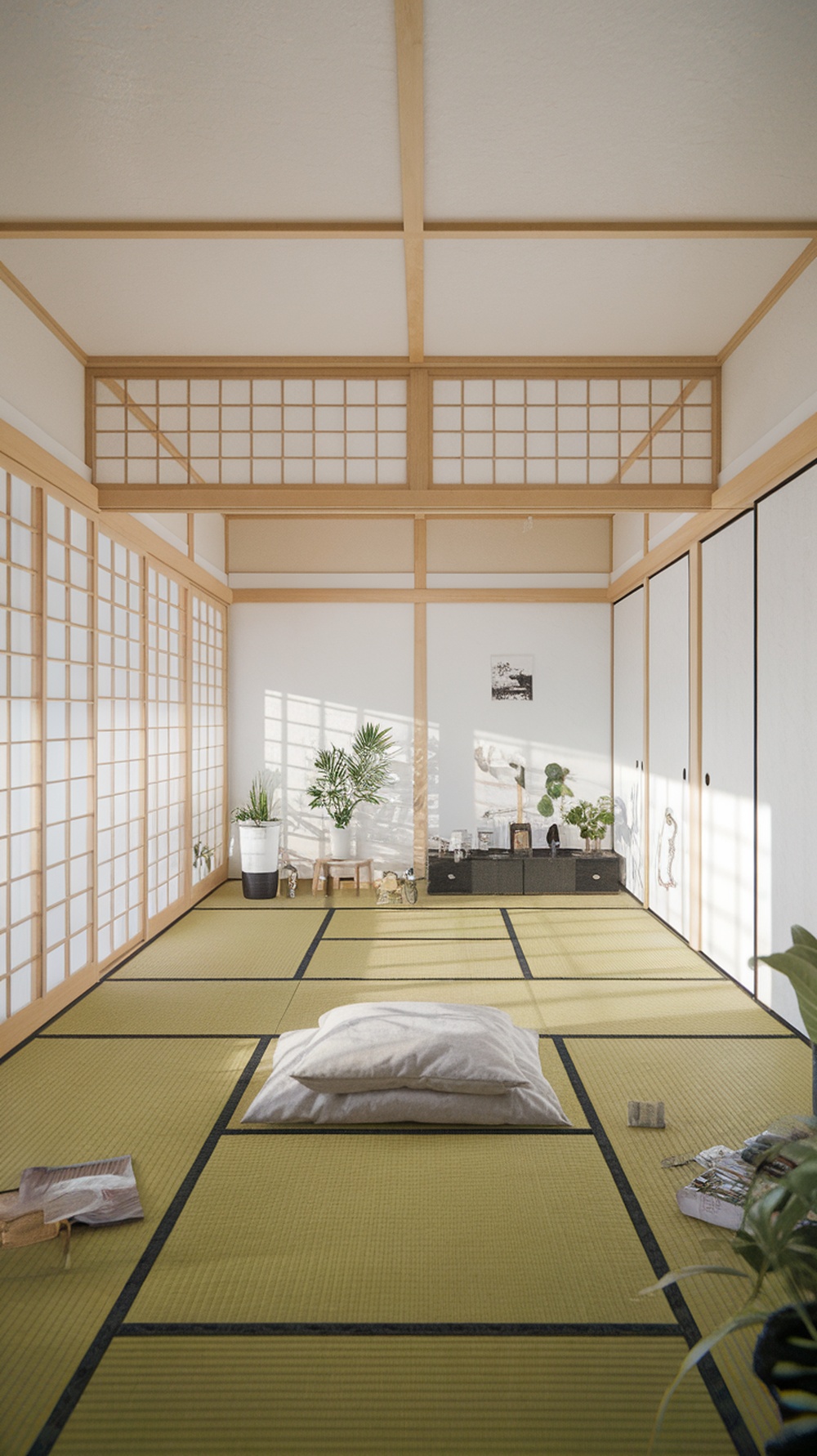
No roundup of Japanese bedroom design ideas is complete without recognizing the importance of natural light. Large windows, glass doors, or strategically placed openings invite soft daylight into your retreat, illuminating textures and highlighting organic details. Embrace sheer curtains or light-filtering blinds that blur the barrier between indoors and outdoors.
Open space is just as important—avoid placing heavy furniture where it impedes energy flow or blocks light. Arrange rooms along the lines of traditional Japanese home design, which favors uncluttered layouts and logical pathways. This creates a peaceful sense of expansion, even within tiny bedrooms. Ultimately, an airy, naturally lit room will always feel more rejuvenating and serene—exactly the feel we’re after with Japanese bedroom design ideas.
Bamboo Accents and Décor
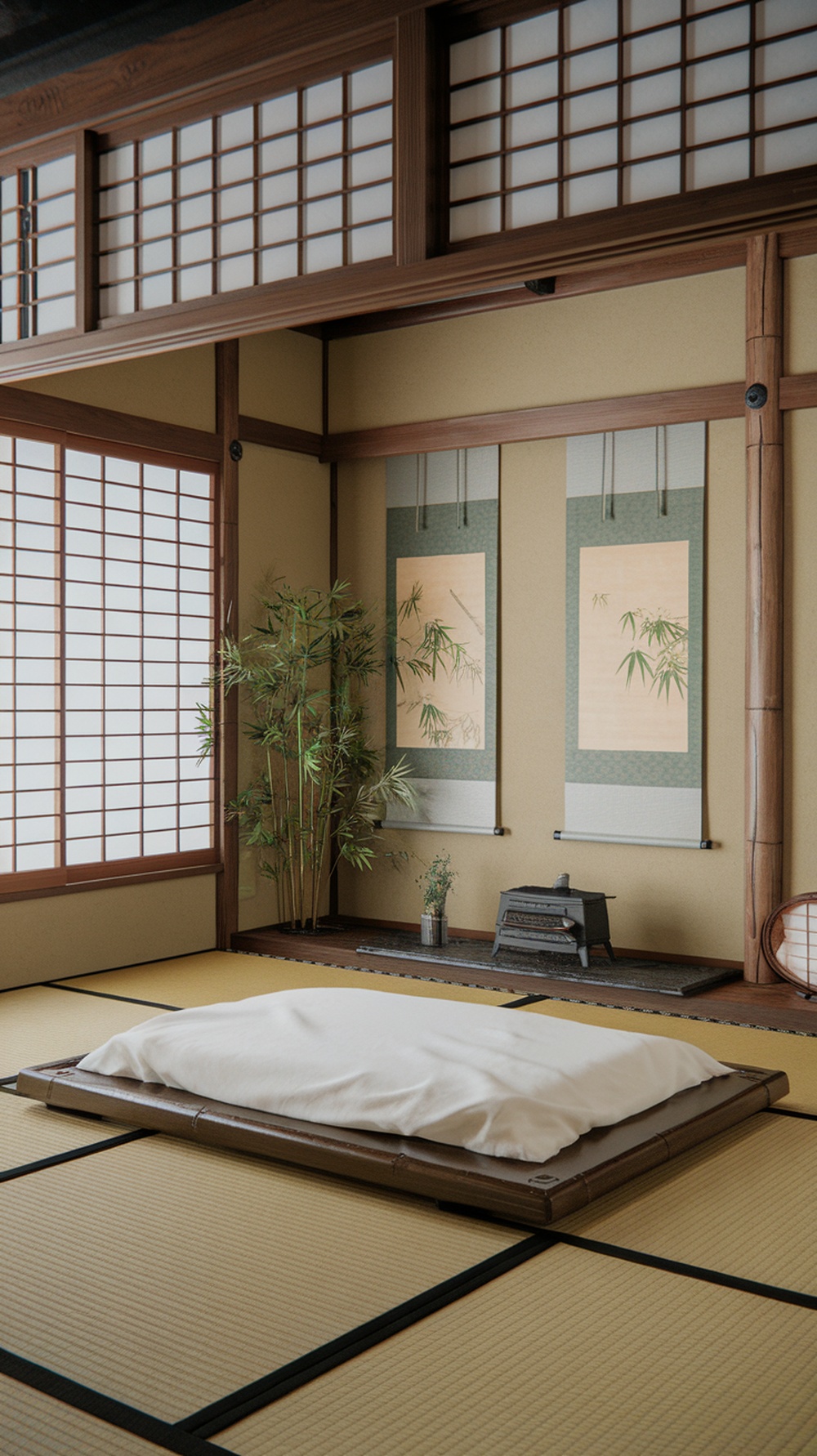
Embrace the timeless charm of bamboo when exploring Japanese bedroom design ideas. Bamboo is celebrated for its eco-friendly qualities and elegant aesthetics. Use bamboo for blinds, headboards, bedside tables, or even wall art. A few subtle accents—a bamboo vase or textured mat—can infuse any space with a fresh, organic energy that underscores the “nature-in-home” philosophy.
Not only is bamboo visually pleasing, but it’s also durable and easy to maintain. The light, golden color pairs beautifully with other natural materials, and its presence conjures images of tranquil Japanese gardens. Whether you opt for small décor items or larger structural pieces, bamboo weaves a thread of authenticity and harmony through your bedroom retreat.
Feng Shui Principles
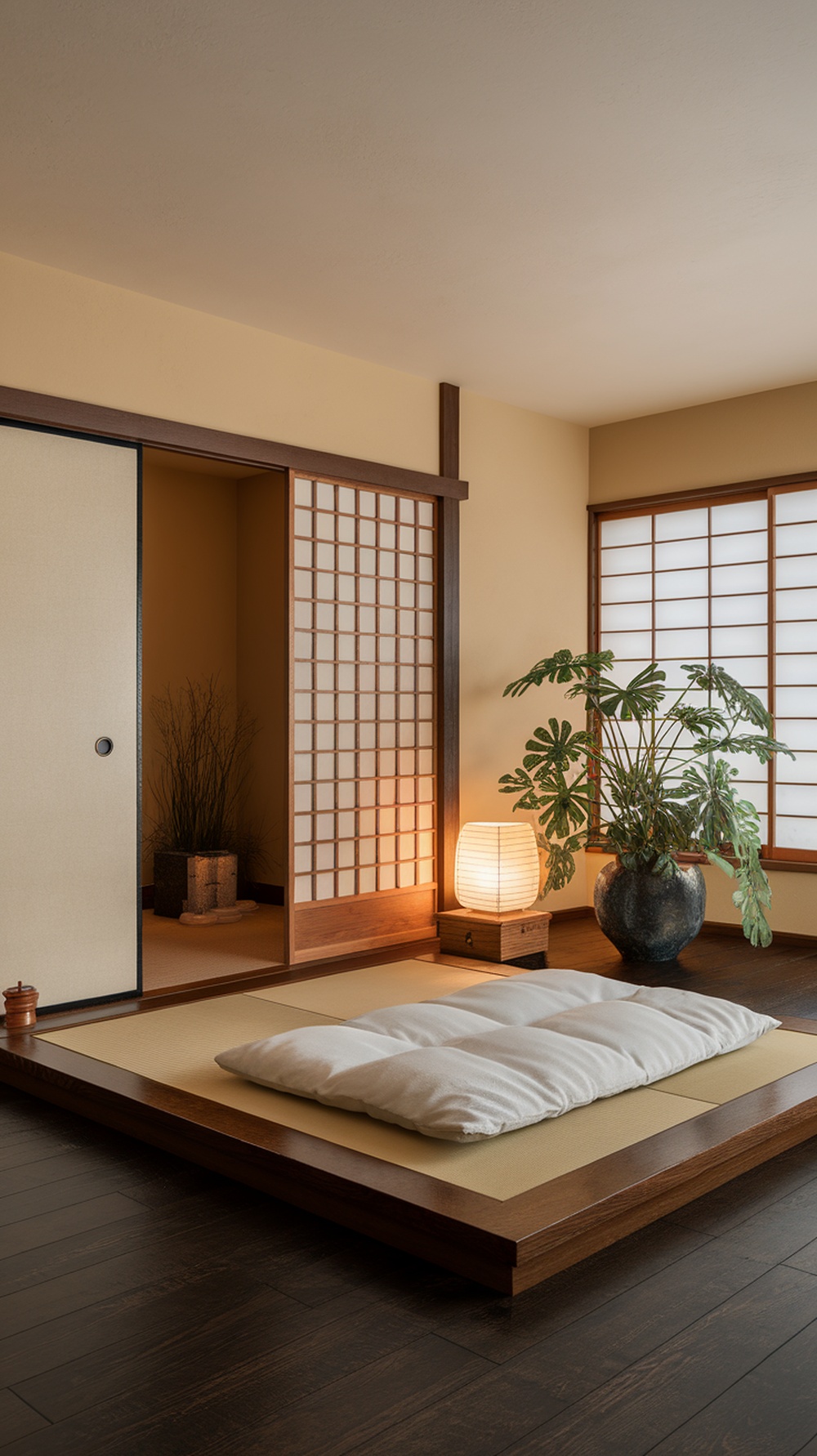
Japanese bedroom design ideas often overlap with feng shui, the art of arranging spaces for optimal energy flow. Creating a balanced room starts with the bed’s placement—ideally, it’s positioned to face the door without being directly aligned with it for a sense of safety and welcome. Avoid mirrors that face the bed, and keep workstations or digital devices out of sight to prevent restlessness.
Incorporate natural elements such as stones or water features. Keep the center of the room open for qi (energy) to circulate. These ancient principles are about more than superstition; they’re about cultivating a nurturing environment where you genuinely feel at ease. Following basic feng shui tips alongside your favorite Japanese bedroom design ideas will effortlessly boost both the beauty and harmony of your space.
Simple Yet Elegant Accessories
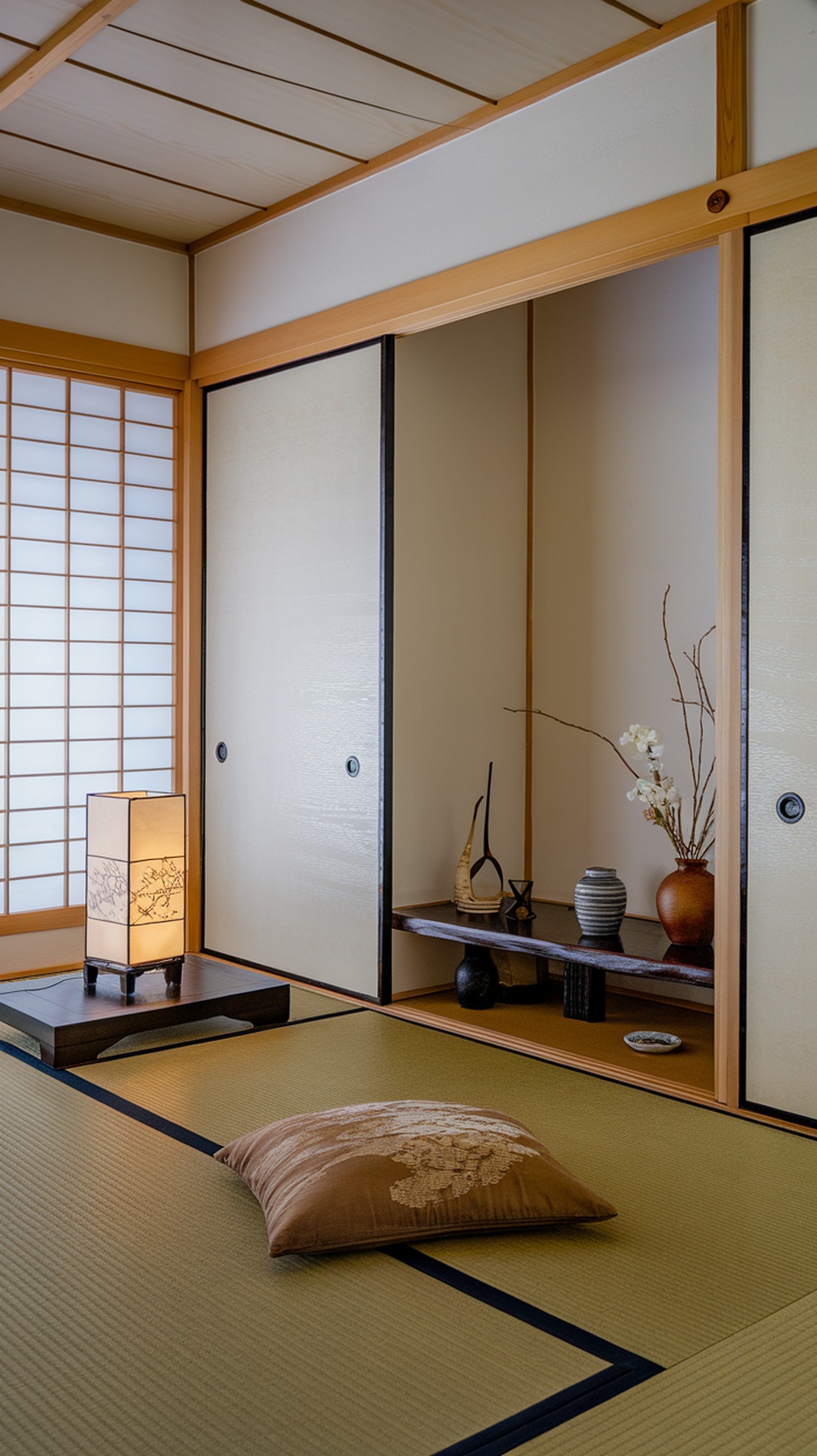
Never underestimate the power of carefully chosen accessories in Japanese bedroom design ideas. Accessories should be thoughtfully curated, avoiding anything fussy or ornamental. Go for a single, vivid ceramic vase, a hand-carved wooden tray, or minimal pendant lights. These touches add personality without disrupting the tranquil energy of your retreat.
Instead of scattering knickknacks, try displaying one or two meaningful items. Perhaps a small stack of smooth river stones or a simple paper lantern. This approach further refines your Japanese bedroom aesthetic, ensuring every object is intentional and contributes to a sense of understated grace.
Incorporating Artwork and Calligraphy
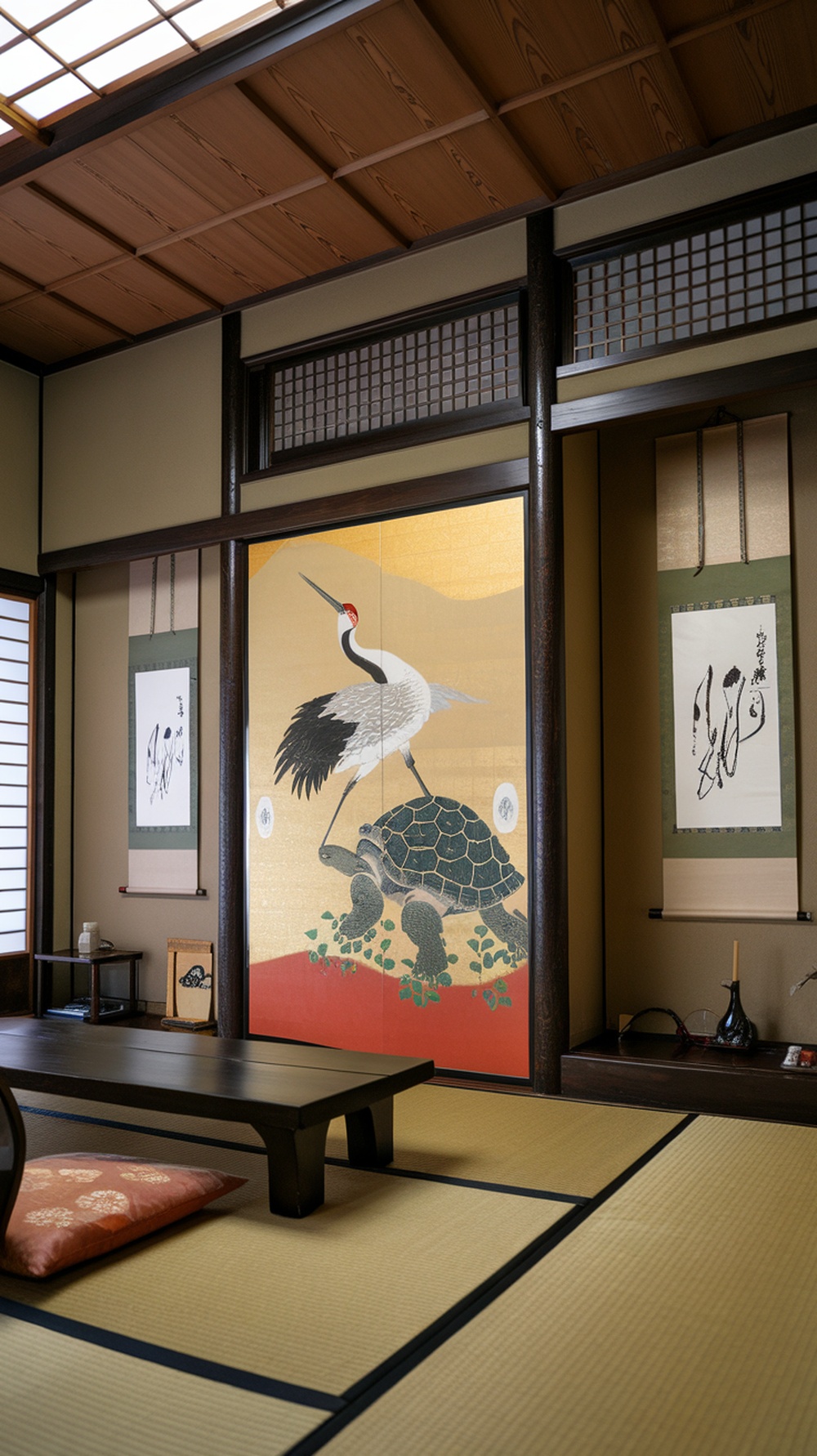
Art has a special place in Japanese bedroom design ideas. Opt for minimal, meaningful pieces such as ink calligraphy, simplistic landscapes, or prints inspired by nature. Hanging a traditional scroll above your bed or showcasing a single painting on a bare wall gives your room a sense of narrative without overwhelming the senses.
For an added layer, incorporate delicately designed ceramics or small statues of cranes or koi fish—symbols of luck and longevity in Japanese culture. Keep frames simple and let negative space accentuate the beauty of each piece. This artistic approach, rooted in Japanese inspired bedroom styles, turns your walls into visual meditations.
Shoji Screen Room Dividers
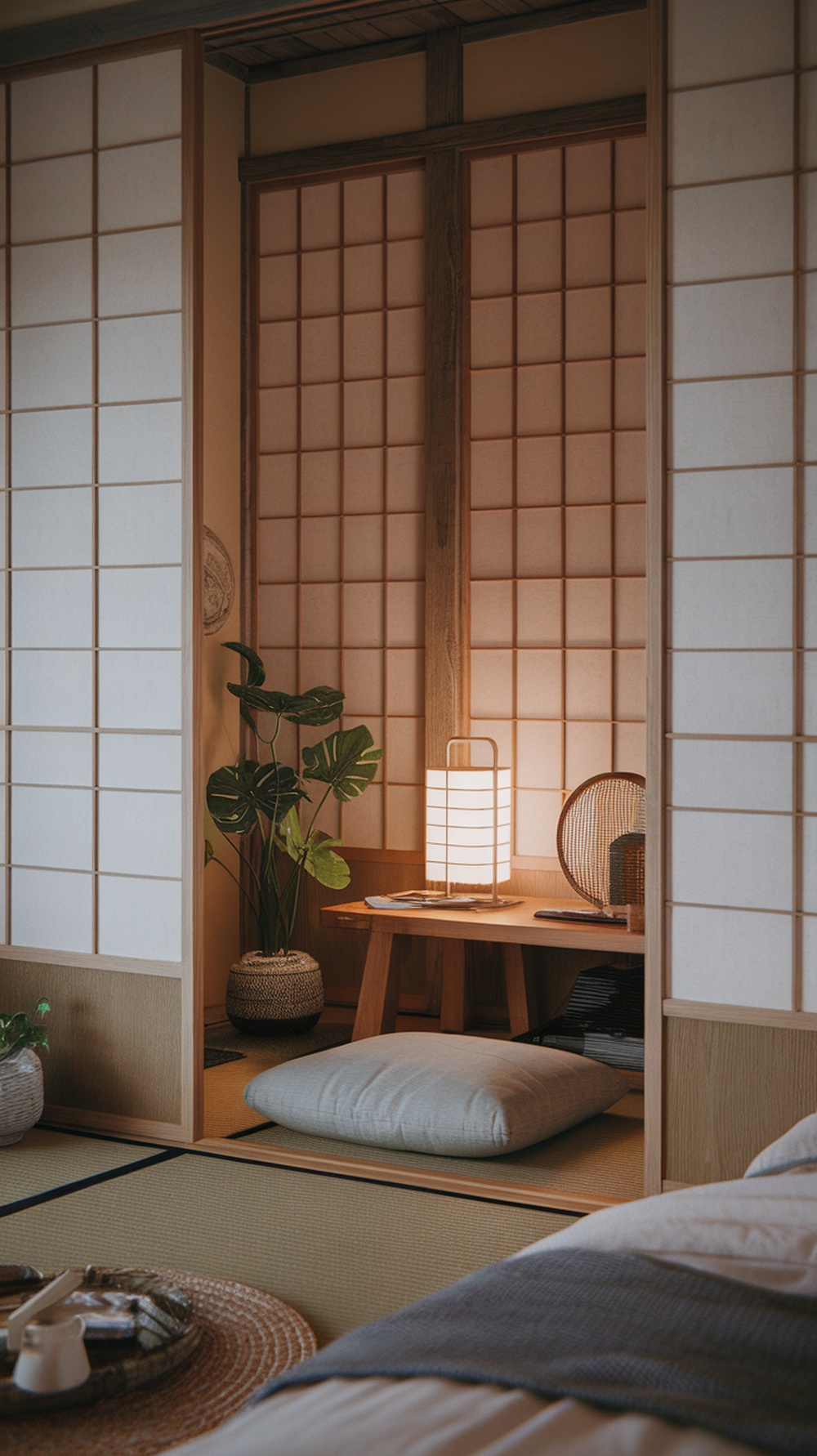
Sometimes, your bedroom needs to wear a few different hats—acting as a workspace, relaxation zone, or even a mini living area. Shoji screen room dividers come to the rescue, offering privacy and visual separation without adding weight or clutter. You can slide or fold these screens to transform the room as needed.
Use them to hide storage areas, create a cozy reading nook, or simply frame your sleeping area for an intimate atmosphere. The translucence of shoji screens ensures that natural light still permeates the space. For fans of the Japandi interior design movement, these screens are an elegant bridge between function and beauty.
Neutrals and Natural Textiles
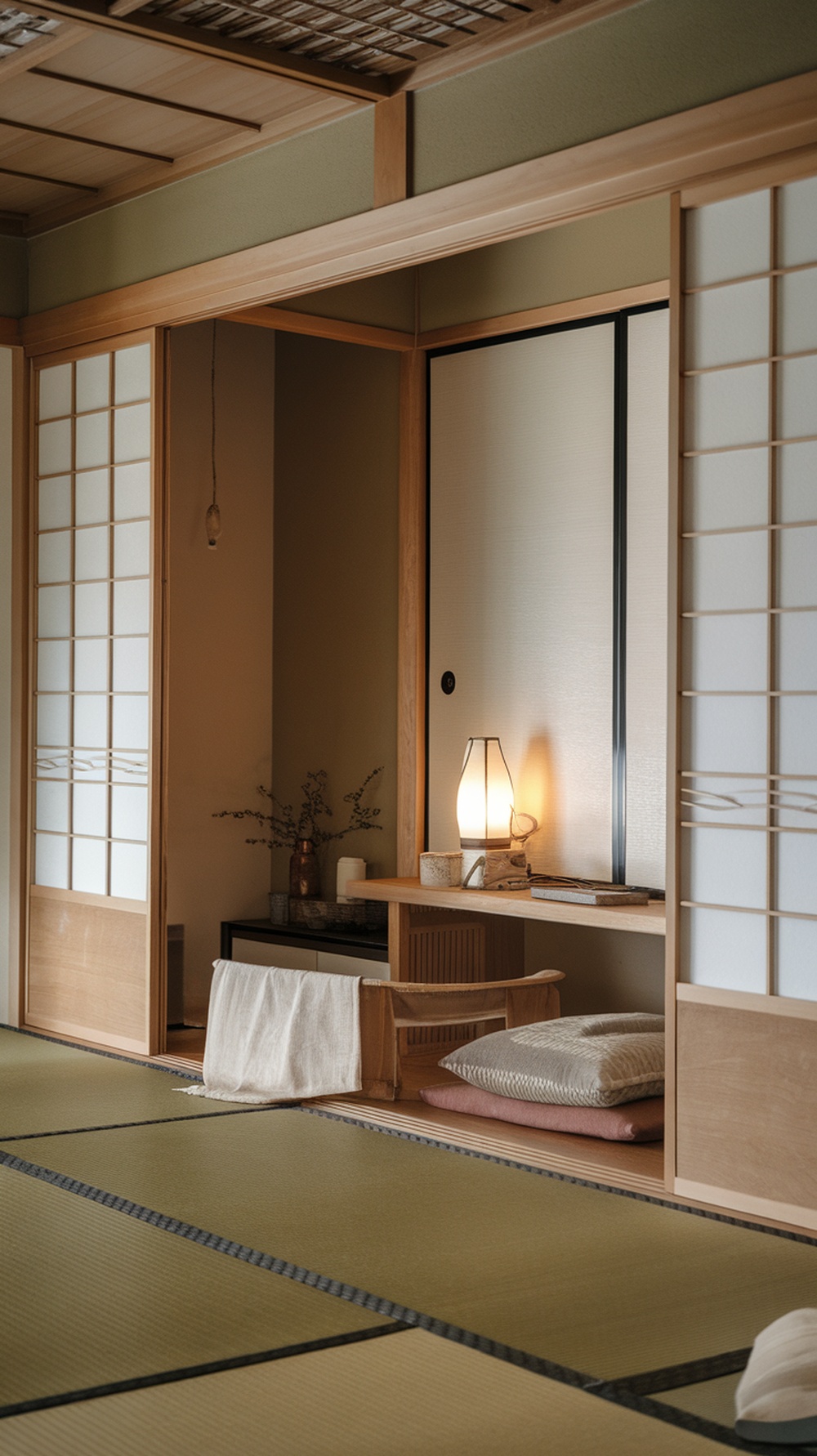
Textiles in Japanese bedroom design ideas often follow a neutral color story—think linen bedding in white or beige, wool throws in oatmeal shades, and tatami-colored rugs. These natural materials feel luxurious against the skin while reinforcing a sense of calm. Opt for organic cotton, hemp, or soft bamboo sheets for a sustainable touch.
Layering neutrals creates depth and interest without overwhelming the senses. Don’t be afraid to mix textures: a chunky knit with a smooth linen duvet, or soft curtains alongside a woven jute mat. The end result? A tactile, cozy haven that embodies the Japanese bedroom aesthetic.
Outdoor Views through Large Windows
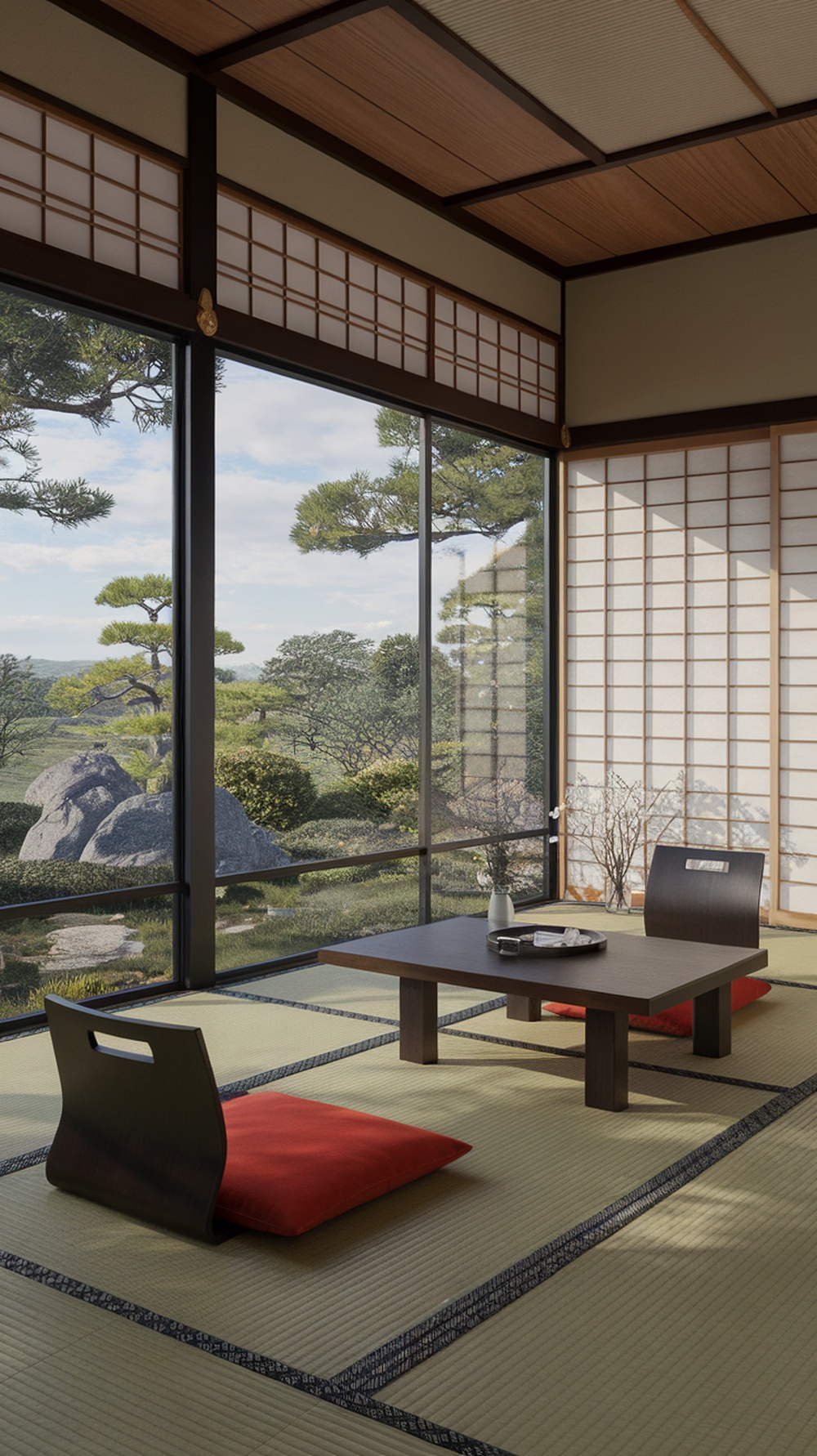
A true Japanese bedroom always invites the outdoors in. Think of large, panoramic windows or sliding glass doors opening onto a courtyard, balcony, or garden. If you’re lucky enough to have a beautiful view, orient your bed towards it—let sunrise or greenery be the first thing you see in the morning. This is the gold standard in Japanese home design.
For privacy, use shoji screens or bamboo blinds that let filtered light in but keep you feeling sheltered. Even in urban landscapes, a carefully positioned window box or mini-garden can turn a city view into something peaceful. With this bedroom Japanese style modern approach, you elevate both the aesthetics and experience of your space.
Tatami Sleeping Platforms
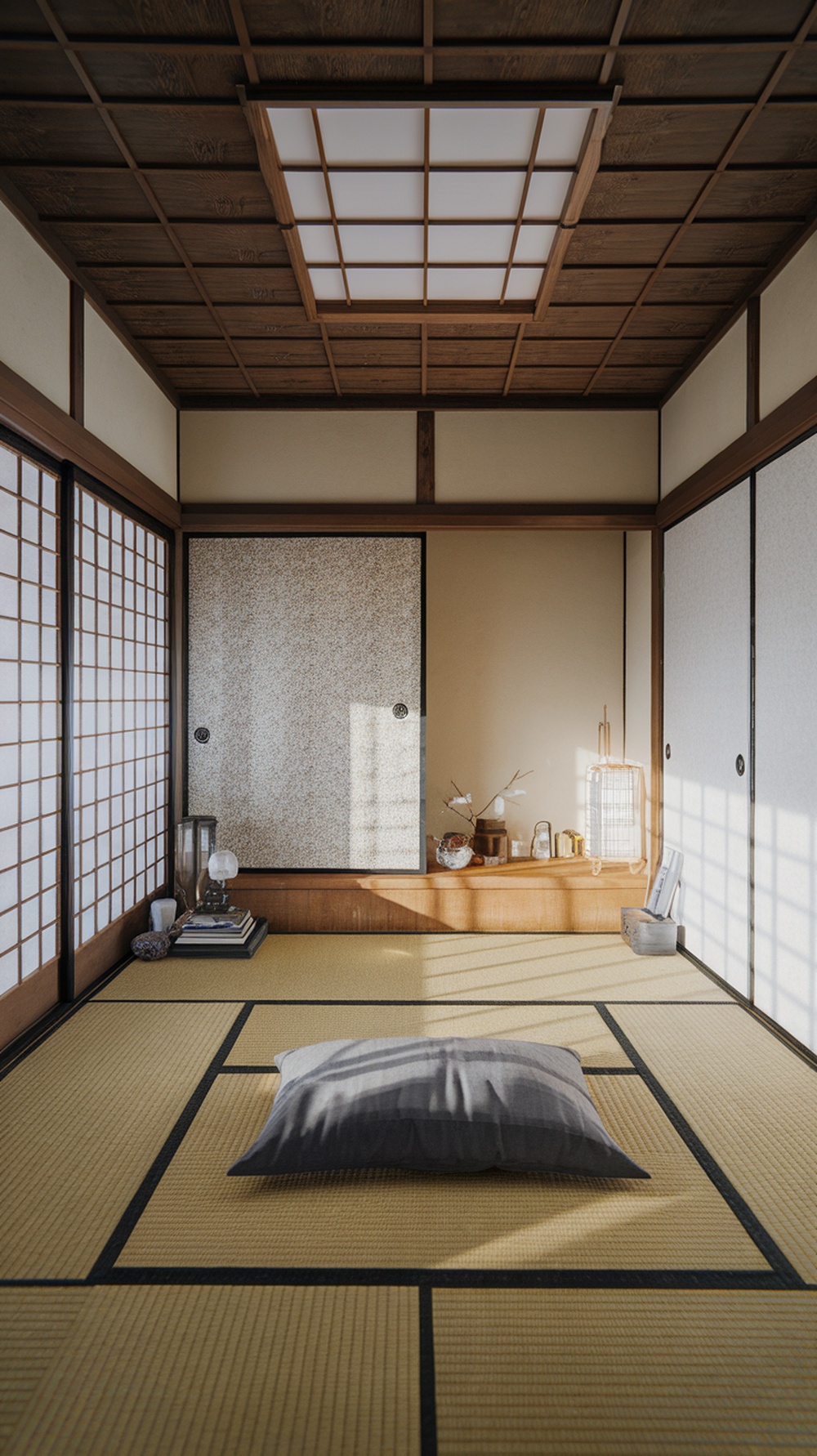
Going a step further than loose tatami mats, a dedicated tatami platform elevates both practicality and style in Japanese bedroom design ideas. These low platforms are typically framed in wood and topped with perfectly fitted tatami mats. Sleeping on a tatami platform connects you to centuries-old traditions, offering firm support and a unique aesthetic that instantly sets your room apart.
Platforms also help define zones within your bedroom, allowing you to distinguish sleeping, reading, or meditation areas. With storage drawers built underneath, these platforms are as smart as they are stylish. If you want a true blend of tradition and modernity—a hallmark of modern Japanese bedroom styles—this feature can’t be beat.
Simplicity in Decor Choices
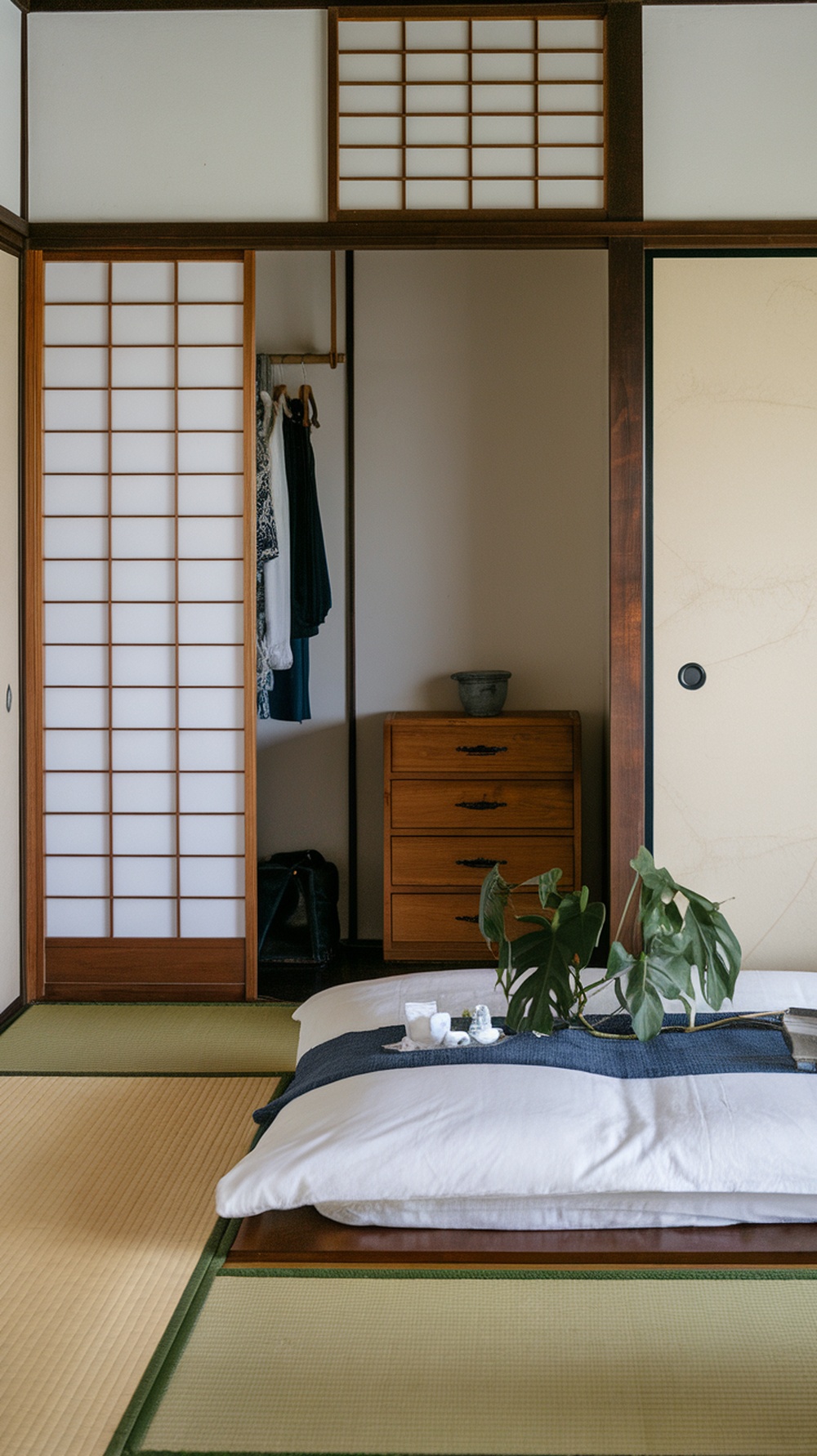
Japanese bedroom design ideas always circle back to simplicity. Before adding anything, ask yourself: Does this item spark joy? Is it useful? This intentional approach is central to maintaining visual clarity and mental calm. For example, rather than covering every surface, select one beautiful bowl or a single ikebana flower arrangement.
This simplicity also applies to wall décor—one wall hanging instead of a scattered gallery, or a single plant over a crowded shelf. By making conscious decisions, your room never feels overdone. The Japanese bedroom aesthetic flourishes in restrained, mindful environments where everything has its place.
Space for Meditation and Relaxation
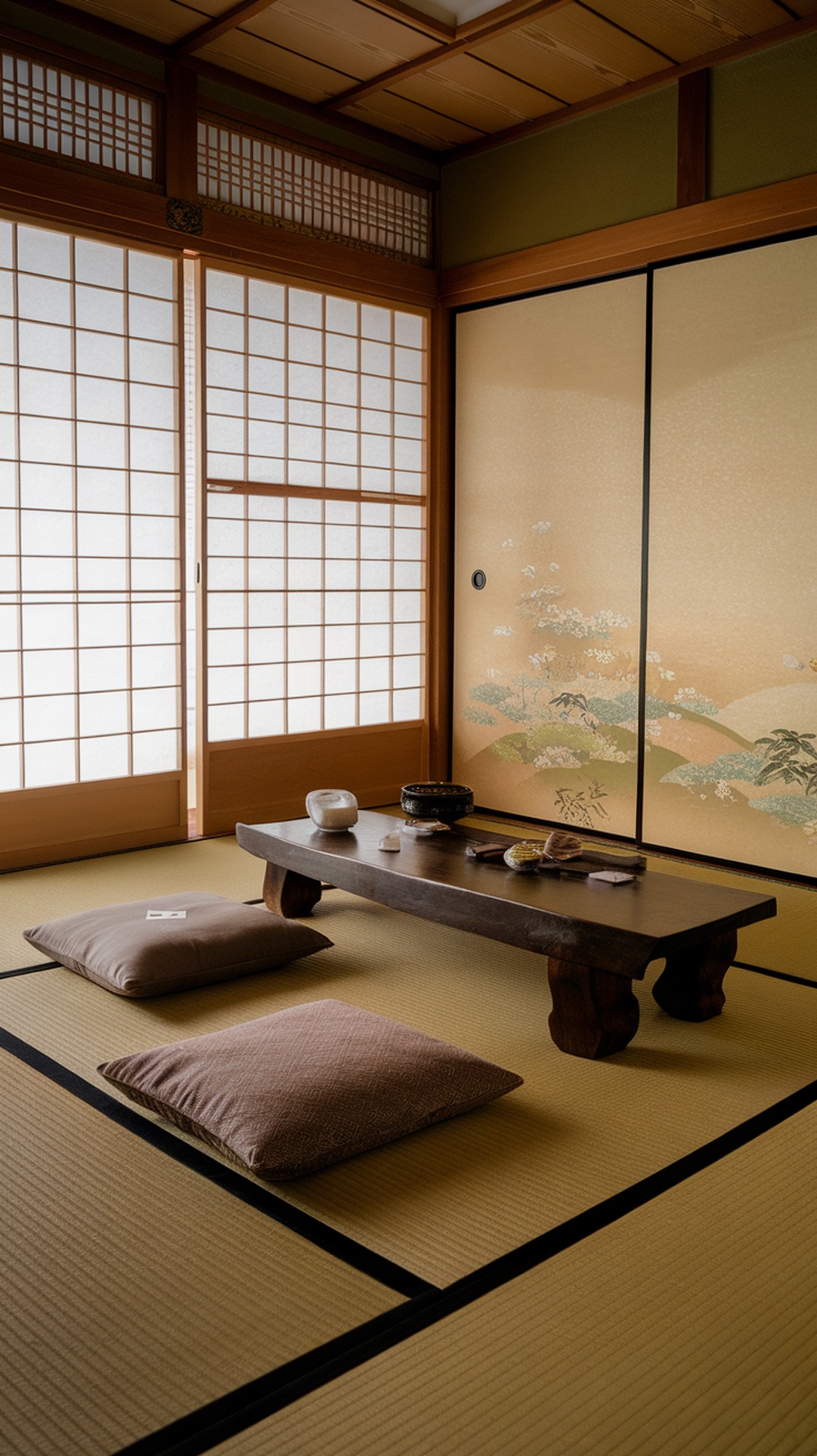
A Japanese bedroom isn’t just for sleeping—it’s for renewing mind, body, and spirit. Carve out a space for quiet reflection. It could be a comfortable cushion by the window, a small tatami mat in a sunny corner, or a simple altar for meditation. This bespoke space encourages you to slow down, breathe, and reconnect.
You might keep a tray with essential oils, a stack of favorite books, or a tea set ready for your daily wind-down ritual. The important thing is intentionality: your relaxation area should feel sacred, soothing, and distinctly yours. With these Japanese bedroom design ideas, wellness becomes seamlessly woven into your daily life.
Soft Textures and Cozy Atmosphere
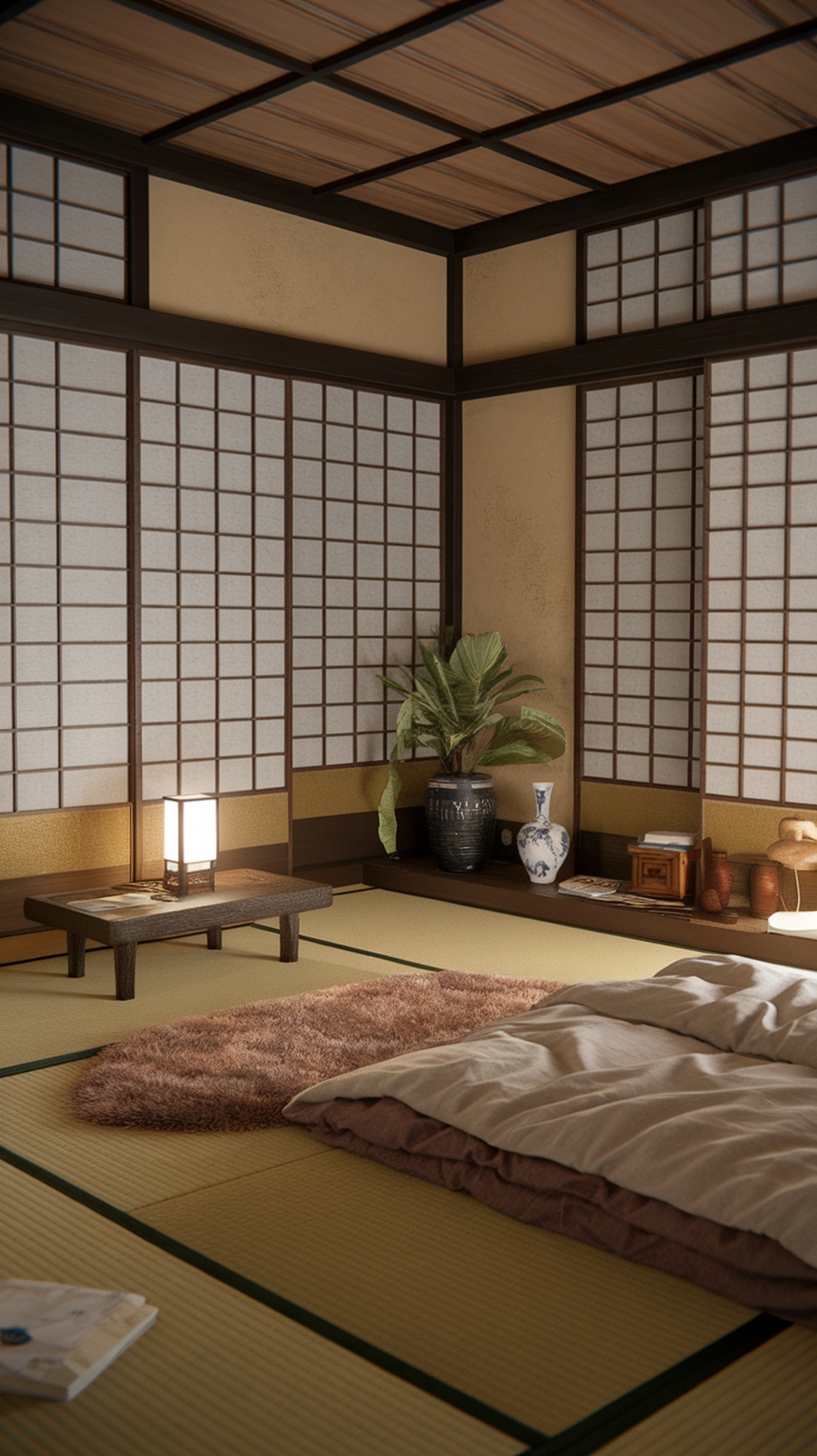
While minimalism is key, soft textures add warmth and approachability. Drape a woolen throw over your futon, add floor cushions for reading, or choose a plush tatami rug to buffer hard flooring. Layered fabrics make the room inviting—perfect for curling up on a chilly evening with a book or journal.
Don’t forget the tactile experience: mix linen, silk, bamboo, and cozy knits for diversity. These little luxuries, thoughtfully integrated, deepen your connection with your bedroom and enhance the tranquil retreat you’re striving for. Japanese bedroom design ideas always balance restraint with comfort, and soft textures are the secret touch.
Seasonal Decor Adaptations
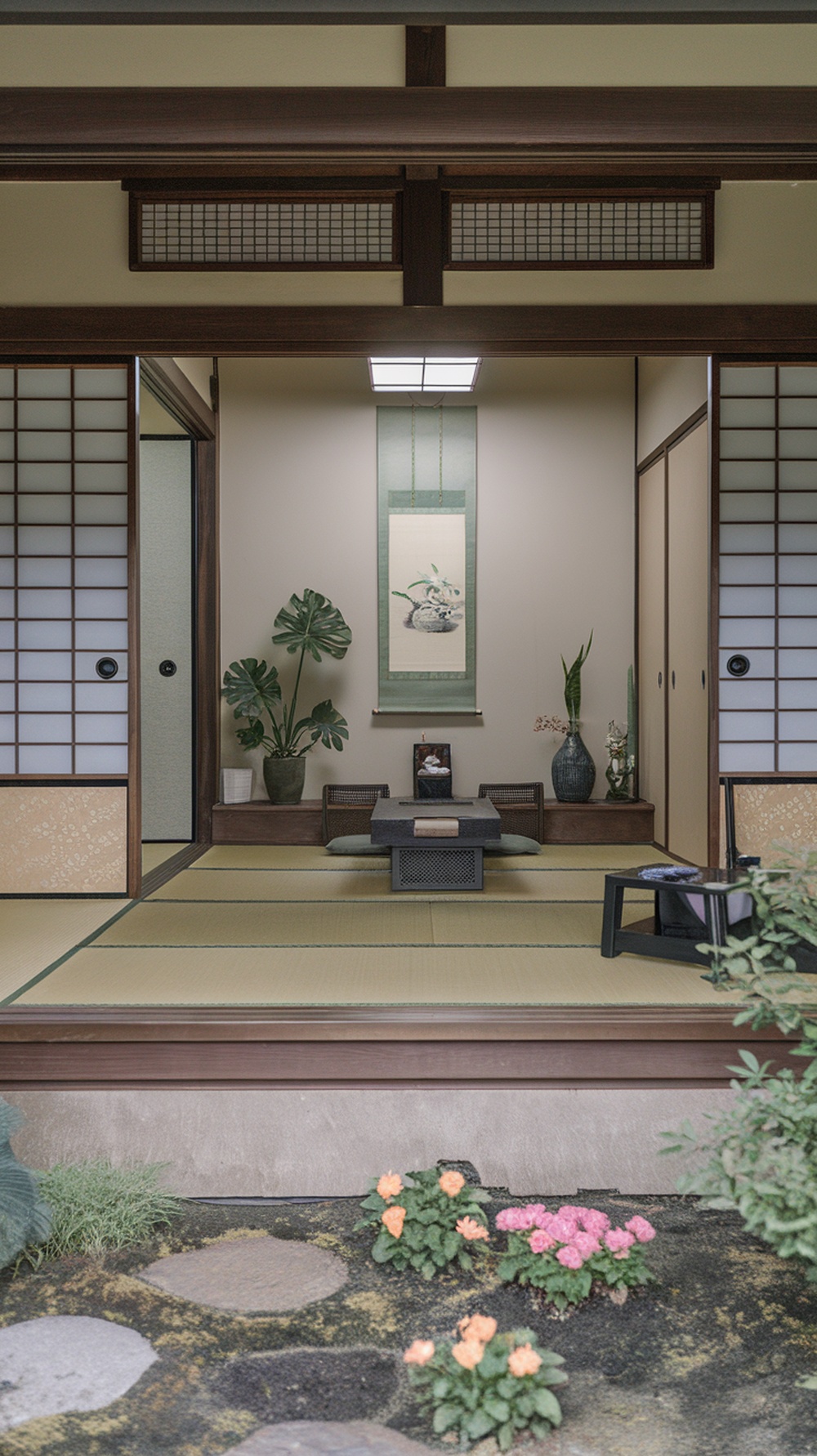
Japanese interior design celebrates the flow of the seasons. Rotate your décor to reflect nature’s changes—a throw blanket and warm curtains in winter, fresh flowers and lighter linens come spring and summer. Scented oils or incense can shift with the weather—try cherry blossom for spring, sandalwood in cooler months.
This approach keeps your bedroom feeling fresh and in tune with the world outside. Swapping out a few accessories or updating your futon cover helps renew your connection to your space. By embracing seasonal changes, you infuse new energy into your Japanese bedroom design ideas without major overhauls.
Layered Lighting Options
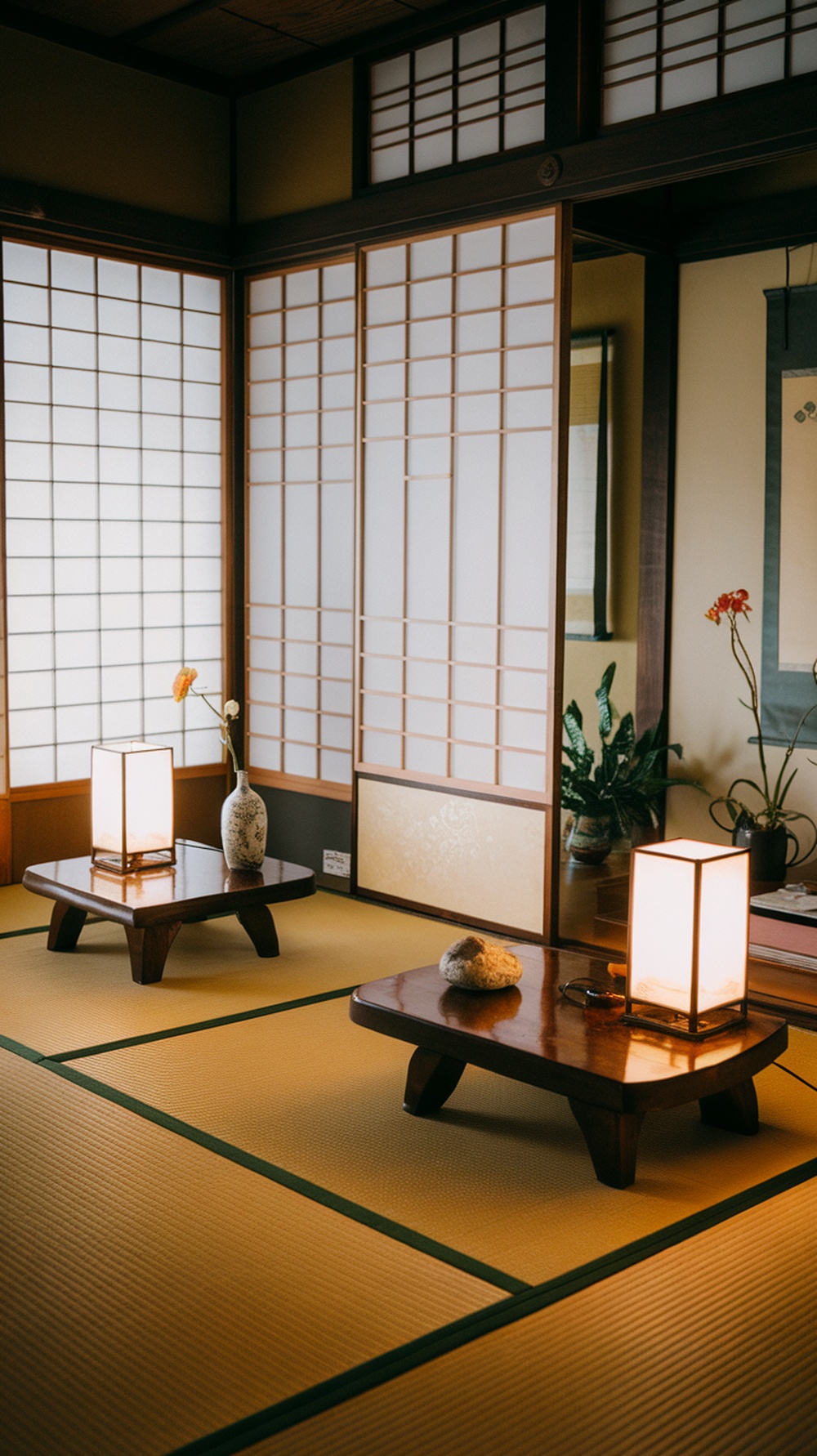
Lighting sets the tone in any bedroom, and in Japanese bedroom design ideas, it’s all about layers. Start with soft, ambient ceiling lights, then add floor or table lamps with rice paper or wooden shades for a warm, diffused glow. Paper lanterns or LED strips under your bed frame can add subtle, magical illumination.
Use lighting to highlight artwork, plants, or unique architectural details. Avoid harsh, cold bulbs—instead, choose warm white to gold tones for ultimate relaxation. Layered lighting provides flexibility and allows you to transition smoothly from bright mornings to peaceful evenings, all while keeping with your Japanese themed bedroom goals.
Cultural Influences in Design

One of the most fascinating aspects of Japanese bedroom design ideas is how each pairing of furniture, color, and materials tells a story of cultural heritage. From Zen aesthetics and Shinto purity to the functional minimalism of modern Japanese life, every component is rooted in generations of lived experience and tradition.
By weaving in elements such as kintsugi-inspired repairs, washi paper lamps, or symbolic motifs like cranes and waves, you honor this rich history. Cultural influence doesn’t mean copying, but rather adapting the spirit of Japanese bedrooms into a setting that makes sense for your lifestyle. It’s about creating meaning and legacy in your most intimate space.
Functional Nook Areas
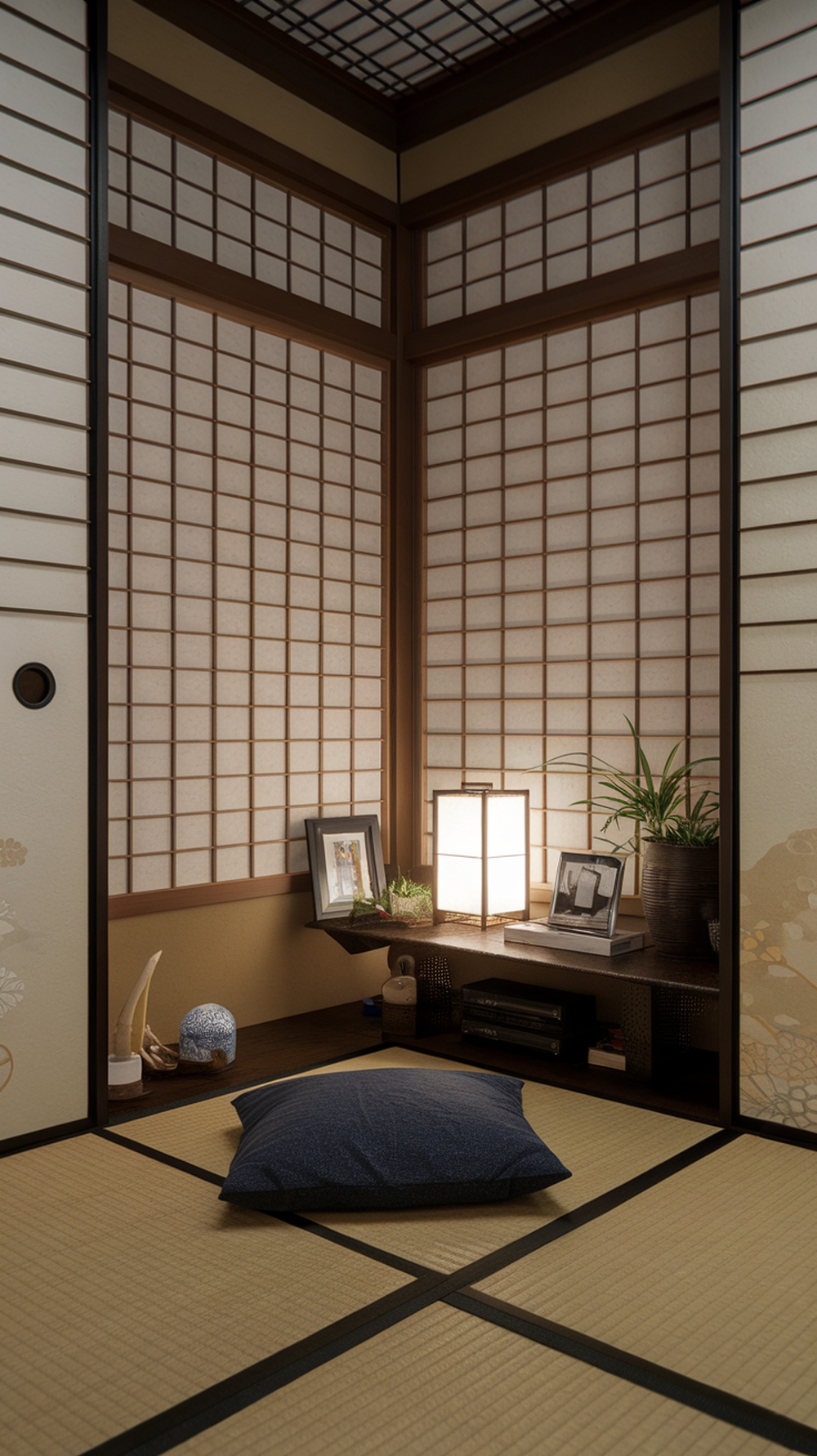
Japanese homes excel at making the most of every inch. Tuck a reading nook into an unused corner, build a mini-office with a low desk, or carve out a yoga or tea spot between your bed and window. Built-in shelving or recessed alcoves (tokonoma) are classic; they let you showcase art or plants without cluttering surfaces.
Even with limited square footage, smart zoning ensures your bedroom does more than just sleeping. These functional nooks reflect the adaptive, forward-thinking mentality intrinsic to modern Japanese bedroom design ideas. It’s about working with your space, not against it.
Warm and Inviting Color Schemes

Don’t fall for the myth that Japanese bedroom design ideas are always stark or cold. Warmth can be achieved through thoughtful use of gold undertones, rust, clay, or even muted coral for accents. These shades partner beautifully with wood, bamboo, and other organic materials for a cozy, inviting appeal.
Soft rugs, textured bedding, and artwork in warm hues help chase away any residual chilliness, making your room feel nurturing as well as stylish. A warm color scheme is the final puzzle piece for anyone hoping to blend Japanese home design with welcoming, everyday livability.
Craftsmanship and Traditional Materials

Finally, the heart of Japanese bedroom design ideas lies in its devotion to superb craftsmanship and time-honored materials. From handwoven tatami mats to meticulously carved joinery, the emphasis is always on quality and attention to detail. Invest in pieces that age gracefully—real wood, shibori-dyed fabrics, hand-glazed ceramics—rather than trendy, disposable accessories.
By appreciating authentic materials and the artisan techniques behind them, you give your bedroom depth and soul. It’s more than a style—it’s a way of living, embracing beauty in both perfection and imperfection. That is, perhaps, the most important secret to creating a tranquil Japanese bedroom retreat.
Conclusion
There you have it—25 inspiring Japanese bedroom design ideas for transforming your bedroom into a tranquil retreat. Whether you lean toward a Japandi bedroom, a Japanese themed bedroom, or crave a modern Japanese bedroom aesthetic, the key is embracing simplicity, mindfulness, and a deep connection to nature and tradition.
With the thoughtful application of these Japanese bedroom design ideas, your space will not only look incredible, but it will also become a sanctuary for your soul. Remember, the journey to calm and beauty starts with one small change—maybe it’s a sliding shoji screen, a lush plant, or just a new neutral bedspread. Dive in, experiment, and enjoy the peaceful results. Sweet dreams!
“`




